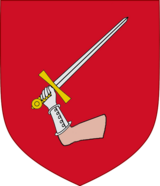| Dalcassians | |||
|---|---|---|---|
| Dál gCais | |||
 The early Dál gCais carried on their banners the Claíomh Solais of Nuada.[1] One of the Four Treasures of the Tuatha Dé Danann. | |||
| Profile | |||
| Country | Ireland | ||
| Region | Thomond | ||
| Ancestry | Déisi Tuisceart | ||
| Ethnicity | Gaelic Irish | ||
| Founder | Cas | ||
| Chief | |||
| Conor John Anthony, 19th Baron Inchiquin | |||
| Historic seat | Dromoland Castle | ||
| |||
| |||
| |||
The Dalcassians (Irish: Dál gCais [ˌd̪ˠaːlˠ ˈɡaʃ]) are a Gaelic Irish clan, generally accepted by contemporary scholarship as being a branch of the Déisi Muman, that became very powerful in Ireland during the 10th century. Their genealogies claimed descent from Tál Cas. Their known ancestors are the subject of The Expulsion of the Déisi tale and one branch of their blood-line went on to rule the petty kingdom of Dyfed in Wales during the 4th century; probably in alliance with the Roman Emperor Magnus Maximus.
Brian Bóruma is perhaps the best-known king from the dynasty and was responsible to a significant degree for carving out their fortunes. The family had built a power base on the banks of the River Shannon and Brian's brother Mahon became their first King of Munster, taking the throne from the rival Eóganachta. This influence was greatly extended under Brian who became High King of Ireland, following a series of wars against Hiberno-Norse kingdoms and the Chiefs of other Irish clans, before dying famously at the Battle of Clontarf in 1014. Following this the Dál gCais provided three more High Kings of Ireland; Donnchad mac Briain, Toirdelbach Ua Briain and Muirchertach Ua Briain.
From the 12th–16th centuries, the Dál gCais contented themselves with being reduced to the Kingdom of Thomond. They attempted to claim the Kingdom of Desmond for a time, but ultimately the MacCarthys held it. The Kennedys also held the Kingdom of Ormond for a time. Some of the better known septs included O'Brien, Moloney, MacNamara, O'Grady, O'Gorman, Galvin, Kennedy, MacMahon, McInerney, and Clancy. During the 13th century Richard Strongbow's relatives the Norman de Clares attempted to take Thomond, but the Dál gCais held firm.
It wasn't until the 16th century, unable to be defeated militarily, that they agreed to surrender and regrant their kingdom to Henry VIII Tudor, joining the nobility of the Kingdom of Ireland. Their realm was renamed County Clare, though they remained influential. In later times, remarkable figures include writer Standish James O'Grady, who is called "Father of the Celtic Revival" and William Smith O'Brien who played a leading part in the Young Irelander Rebellion of 1848. In diaspora, prominent figures have included Marshal Patrice de Mac-Mahon, President of France,[2][3] as well as John F. Kennedy[4] and Ronald Reagan,[5] who were both Presidents of the United States.
- ^ "Coat of Arms". The O'Brien Clan. 8 March 2011. Archived from the original on 3 March 2012.
- ^ The Tribe of Cas (26 August 2011). "Pedigree of MacMahon, Lords of Corca Baisgin, County Clare". Archived from the original on 21 November 2010. Retrieved 29 May 2012.
- ^ Family History Ireland (26 August 2011). "Marshal MacMahon and the Ottomans". Archived from the original on 21 December 2012. Retrieved 29 May 2012.
- ^ Family Steps by Leanne Chilver (29 May 2012). "Kennedy Origins Story".
- ^ Clan O'Reagan (29 May 2012). "Reagan Presidential Memorial".